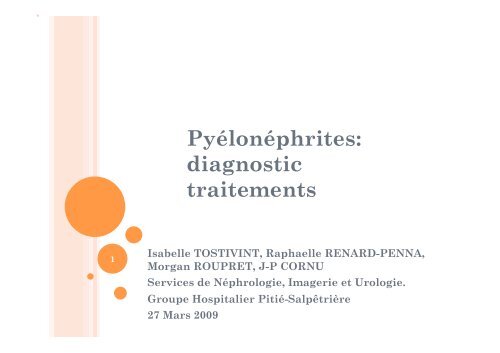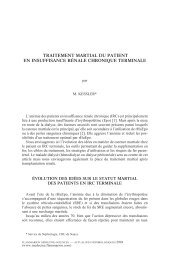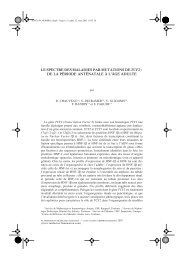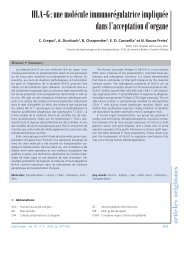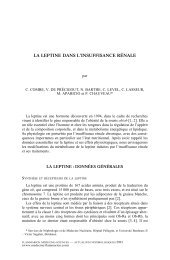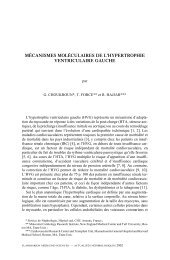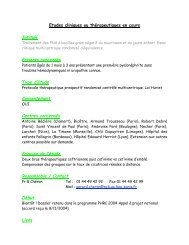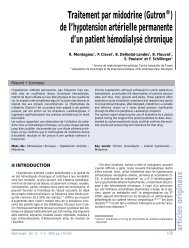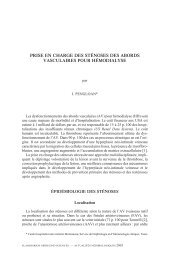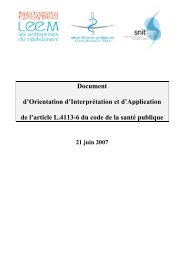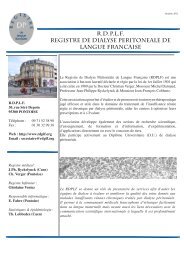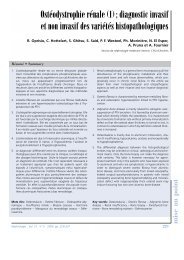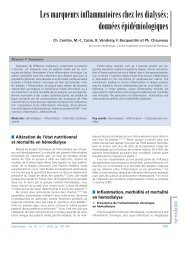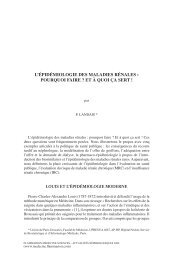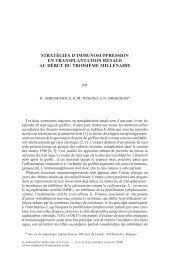Pyélonéphrites : diagnostic et traitement
Pyélonéphrites : diagnostic et traitement
Pyélonéphrites : diagnostic et traitement
You also want an ePaper? Increase the reach of your titles
YUMPU automatically turns print PDFs into web optimized ePapers that Google loves.
1<br />
<strong>Pyélonéphrites</strong>:<br />
<strong>diagnostic</strong><br />
<strong>traitement</strong>s<br />
Isabelle TOSTIVINT, Raphaelle RENARD-PENNA,<br />
Morgan ROUPRET, J-P CORNU<br />
Services de Néphrologie, Imagerie <strong>et</strong> Urologie.<br />
Groupe Hospitalier Pitié-Salpêtrière<br />
27 Mars 2009
Pyélonéphrite Aigue non compliquée<br />
infection du haut appareil urinaire fréquente<br />
prévalence : 5%dans la population féminine.<br />
femme jeune non enceinte <strong>et</strong> sans antécédents particuliers<br />
Le pronostic ultérieur est dominé, d’une part, par la possibilité<br />
de cicatrice scléreuse rénale <strong>et</strong>, d’autre part, par le risque de<br />
passage à la chronicité <strong>et</strong> de destruction à bas bruit du<br />
parenchyme rénal<br />
<strong>diagnostic</strong> : anamnèse + examen clinique +ECBU<br />
Échographie en moins de 24 h pour éliminer un obstacle<br />
Uroscanner : référence pour déterminer l’aspect des lésions<br />
parenchymateuses <strong>et</strong> la présence éventuelle d’une obstruction<br />
associée.<br />
Monoantibiothérapie probabiliste contre Escherichia coli 2<br />
adaptée secondairement à l’antibiogramme d’une durée de 10 à<br />
14 jours
Facteurs de risque de pyélonéphrite<br />
aiguë • sexe féminin primitive ;<br />
• âge avancé > 55 ans ;<br />
• antécédent personnel d’infection urinaire<br />
• grossesse ;<br />
• rapport sexuel sans miction postcoïtale ; contraceptifs<br />
locaux (spermicides, diaphragme utérin,<strong>et</strong>c.) ;<br />
• prolapsus pelvien génito-urinaire ; lithiases rénales ;<br />
reflux vésico-urétéral anomalie anatomique ou<br />
fonctionnelle de l’arbre urinaire : obstruction, corps<br />
étranger, sonde vésicale, rein unique, vessie neurologique,<br />
polykystose rénale, <strong>et</strong>c.<br />
• immunodépression/anomalie métabolique : diabète, VIH,<br />
transplantation d’organe, corticothérapie au long cours, <strong>et</strong>c.<br />
3
un danger: l’obstruction urinaire<br />
stase malmène les mécanismes de défense non<br />
spécifiques du haut comme du bas appareil<br />
Le flux urinaire<br />
dilatation des cavités pyélocalicielles puis des tubes<br />
collecteurs : passage des agents microbiens dans la<br />
zone médullaire <strong>et</strong> le tissu interstitiel.<br />
lithiases rénales : facilitent l’adhérence des bactéries<br />
à l’urothélium par lésion itérative du film de<br />
mucopolysaccharide naturel protecteur<br />
Le reflux vésico-urétéral<br />
4
Bactéries en cause dans les IU.<br />
Bactéries Fréquence<br />
Escherichia coli 70-95 %<br />
Staphylococcus saprophyticus 5-20 % (surtout chez les femmes<br />
jeunes pendant l’été)<br />
Autres entérobactéries < 5 %<br />
Proteus mirabilis<br />
Klebsiella pneumoniae<br />
Enterobacter sp.<br />
Enterococci sp.<br />
Staphylococcus aureus Très rare, suggère l’existence<br />
d’une source bactérienne<br />
Atypique Parfois difficile à diagnostiquer<br />
en milieu de culture<br />
Ureaplasma urealyticum<br />
5
Physiopathologie: mode de<br />
contamination<br />
L’infection des cavités excrétrices rénales se fait <br />
par voie rétrograde ascendante <strong>et</strong> atteint <br />
secondairement le parenchyme rénal. <br />
La vascularisation importante du parenchyme rénal <br />
favorise le passage systémique des germes avec <br />
possible septicémie <strong>et</strong> choc septique. <br />
Les sites d’infection de l’urothélium <strong>et</strong> du <br />
parenchyme rénal sont le siège d’oedème, d’afflux <br />
leucocytaire <strong>et</strong> d’ischémie localisée, responsables <br />
de microabcès.<br />
6
Physiopathologie: mode de contamination<br />
l’hôte (stase urinaire, modifications urodynamiques de<br />
la grossesse, glycosurie du diabète...), soit par<br />
implantation dans flore urétrale d’une bactérie<br />
particulièrement virulente dite uropathogène (sources<br />
d’E. coli productrices d’une ou de plusieurs adhésines<br />
ou fimbriae ou pili)<br />
La PA survient chez la femme lorsque les agents<br />
uropathogènes de la flore fécale colonisent le vagin<br />
proximal, remontent vers la vessie puis vers les reins<br />
via les ur<strong>et</strong>ères.<br />
La voie de contamination hématogène ne s’observe<br />
qu’au cours d’états pathologiques particuliers<br />
(septicémie, bactériémie, <strong>et</strong>c.) <strong>et</strong> les germes isolés<br />
associent à la flore habituellement observée d’autres<br />
espèces bactériennes (Staphylococcus aureus,<br />
Salmonella, levures, <strong>et</strong>c.).<br />
7
Virulence adhérence bactérienne : essentielle pour comprendre le rôle<br />
pathogène des colibacilles dans la genèse <strong>et</strong> la diffusion de<br />
l’infection urinaire.<br />
flagelles (antigène H), fines fibrilles protéiques décrites sous le<br />
nom de pili (ou « fimbriae »)<br />
génétiquement par le patrimoine chromosomique de la bactérie <strong>et</strong><br />
sont de deux types : I (pili mannose sensible) <strong>et</strong> II (pili mannoserésistant).<br />
immunogènes <strong>et</strong> jouent un rôle d’endotoxine.<br />
endotoxines : fibres musculaires lisses, atonie de la voie excrétrice,<br />
Sur le plan systémique, elles sont à l’origine des manifestations<br />
générales qui accompagnent l’infection comme la fièvre,<br />
l’hyperleucocytose<br />
8<br />
Ce sont ces lipopolysaccharides, porteurs de l’antigène O ou K, qui<br />
perm<strong>et</strong>tent de définir les différents sérotypes de colibacilles (> 150<br />
existants)
Eur J Clin Invest. 2008 Oct;38 Suppl 2:12-20<br />
TLR- and CXCR1-dependent innate immunity: insights into the<br />
gen<strong>et</strong>ics of urinary tract infections.<br />
Ragnarsdóttir B, Fischer H, Godaly G, Grönberg-Hernandez J, Gustafsson M, Karpman D, Lundstedt AC, Lutay N, Rämisch<br />
S, Svensson ML, Wullt B, Yadav M, Svanborg C.<br />
Department of Microbiology, Immunology & Glycobiology (MIG), Institute of Laboratory Medicine, Lund University, Lund, Sweden.<br />
The susceptibility to urinary tract infection (UTI) is controlled by the innate immune response and Toll like receptors (TLRs) are the<br />
sentinels of this response. If productive, TLR4 signalling may initiate the symptomatic disease process. In the absence of TLR4<br />
signalling the infected host instead develops an asymptomatic carrier state. The activation of mucosal TLR4 is also influenced by the<br />
properties of the infecting strain, and pathogens use their virulence factors to trigger 'pathogen-specific' TLR4 responses in the<br />
urinary tract but do not respond to the asymptomatic carrier strains in patients with asymptomatic bacteriuria (ABU). The TLR4<br />
dependence has been demonstrated in mice and the relevance of low TLR4 function for protection for human disease was recently<br />
confirmed in children with asymptomatic bacteriuria, who expressed less TLR4 than age matched controls. Functional chemokines and<br />
functional chemokine receptors are crucial for neutrophil recruitment, and for the neutrophil dependent bacterial clearance.<br />
Interleukin (IL)-8 receptor deficient mice develop acute septic infections and chronic tissue damage, due to aberrant neutrophil<br />
function. This mechanism is relevant for human UTI as pyelonephritis prone children express low levels of the human CXCL8 (Il-8)<br />
receptor, CXC chemokine receptor 1 (CXCR1) and often have h<strong>et</strong>erozygous CXCR1 polymorphisms. This review illustrates how<br />
intimately the innate response and the susceptibility to UTI are linked and sophisticated recognition mechanisms that rely on<br />
microbial virulence and on host TLR4 and CXCR1 signalling.<br />
9
Current concepts of molecular defence mechanisms operative during urinary tract infection.<br />
1: Eur J Clin Invest. 2008 Oct;38 Suppl 2:29-38. Links<br />
Weichhart T, Haidinger M, Hörl WH, Säemann MD.<br />
Department of Medicine III, Division of Nephrology and Dialysis, Medical University Vienna, Vienna, Austria.<br />
Mucosal tissues such as the gastrointestinal tract are typically exposed to a tremendous number of microorganisms and many of them are potentially<br />
dangerous to the host. In contrast, the urogenital tract is rather infrequently colonized with bacterial organisms and also devoid of physical barriers as a<br />
multi-layered mucus or ciliated epithelia, thereby necessitating separate host defence mechanisms. Recurrent urinary tract infection (UTI) represents the<br />
successful case of microbial host evasion and poses a major medical and economic health problem. During recent years considerable advances have been<br />
made in our understanding of the mechanisms underlying the immune homeostasis of the urogenital tract. Hence, the system of pathogen-recognition<br />
receptors including the Toll-like receptors (TLRs) is able to sense danger signalling and thus activate the host immune system of the genitourinary tract.<br />
Additionally, various soluble antimicrobial molecules including iron-sequestering proteins, defensins, cathelicidin and Tamm-Horsfall protein (THP), as well<br />
as their role for the prevention of UTI by modulating innate and adaptive immunity, have been more clearly defined. Furthermore, signalling mediators like<br />
cyclic adenosine monophosphate (cAMP) or the circulatory hormone vasopressin were shown to be involved in the defence of uropathogenic microbes and<br />
maintenance of mucosal integrity. Beyond this, specific receptors e.g. CD46 or b<strong>et</strong>a1/b<strong>et</strong>a 3-integrins, have been elucidated that are hijacked by<br />
uropathogenic E. coli to enable invasion and survival within the urogenital system paving the way for chronic forms of urinary tract infection. Collectively,<br />
the majority of these findings offer novel avenues for basic and translational research implying effective therapies against the diverse forms of acute and<br />
chronic UTI.<br />
10
Mode moyens de aspécifiques défense : flux naturelle urinaire, fréquence des mictions<br />
complètes,<br />
intégrité <strong>et</strong> imperméabilité de l’urothélium (glycosaminoglycanes de<br />
surface <strong>et</strong> cellules urothéliales),<br />
protéine de Tamm-Horsfall sécrétée par le rein (chélatrice à<br />
Escherichia coli pili de type I) riche en résidu mannose, produite<br />
par le segment ascendant de l’anse de Henle exerce un « eff<strong>et</strong> de<br />
leurre » sur les E. coli possédant des pili de type I<br />
couche de mucopolysaccharides (GAG): sur muqueuse urothéliale,<br />
prévention de l’adhérence des bactéries aux cellules du tractus<br />
urinaire.<br />
Concentration élevée en urée, acides organiques urinaires, pH acide<br />
Les sécrétions prostatiques : eff<strong>et</strong> inhibiteur sur la croissance<br />
bactérienne<br />
Chez la femme, l’infection urinaire est favorisée par la brièv<strong>et</strong>é<br />
urétrale, la modification de la flore, la modification du pH vaginal,<br />
(augmentation du pH > 4,4) par la diminution physiologique des<br />
oestrogènes après la ménopause ou certaines habitudes d’hygiène<br />
(douches vaginales) facilitent la colonisation vaginale puis urétrale<br />
par les bactéries digestives<br />
11
Mécanismes immunologiques<br />
IgA sécrétoires semblent jouer un rôle important dans la prévention de <br />
l’adhésion des bactéries aux cellules urothéliales <br />
réponse immunitaire va se développer rapidement en réponse aux <br />
antigènes bactériens. <br />
Initialement, voies de l’inflammation <strong>et</strong> de la réponse immune qui sont <br />
activées, suivies de l’arrivée des lymphocytes <strong>et</strong> des cytokines. <br />
activation des IL 1, 6 <strong>et</strong> 8, dont la concentration est augmentée à la fois <br />
dans les urines <strong>et</strong> le sérum, était directement dépendante de l’adhésion <br />
des colibacilles sur les cellules urothéliales <br />
Recrutement de PNN sur le site de l’infection <strong>et</strong> initient la réaction <br />
inflammatoire <br />
L’augmentation du taux de cellules CD4 dans la phase aiguë de <br />
l’infection : migration de cellules de l’inflammation de la circulation <br />
générale vers le site d’expression de l’antigène par la bactérie. <br />
La phagocytose débute sur le site de l’infection en présence des <br />
macrophages. Ce phénomène, associé à l’ischémie engendrée par <br />
l’obstruction des microvaisseaux, est responsable du relargage de <br />
radicaux libres qui induisent des lésions tissulaires irréversibles, <br />
conduisant à l’apoptose cellulaire prématurée. <br />
12
actuellement aucun doute que les pili de type II sont le facteur <br />
déclenchant majeur de la réponse en phase aiguë, il semble que <br />
ces fimbriae jouent aussi un rôle important dans l’initiation de la <br />
seconde vague de réponse par l’organisme. <br />
En fixant la fibronectine, les pili m<strong>et</strong>tent à découvert certaines <br />
cellules capables d’initier une réponse immunologique plus <br />
appropriée par l’organisme. <br />
Une réaction systémique se développe ensuite avec des anticorps <br />
dirigés successivement contre les antigènes O <strong>et</strong> K <strong>et</strong> contre les pili <br />
de type I ou II présentés par les colibacilles <br />
. Dans les infections urinaires hautes, des IgM, des IgG puis des IgA <br />
sont produits au niveau sérique sous le contrôle des lymphocytes T <br />
qui infiltrent le rein. Bien que les pili soient les facteurs de virulence <br />
bactérienne les plus importants dans la pyélonéphrite aiguë, <br />
d’autres pilis (X, S, <strong>et</strong>c.) <strong>et</strong> d’autres modes d’adhésion bactériens <br />
semblent également entrer en jeu. La combinaison de multiples <br />
facteurs de virulence, comme l’association de pili type I, hémolysine <br />
<strong>et</strong> aérobactine est assez fréquente dans les pyélonéphrites aiguës <br />
sévères. La <br />
13
Pathogenesis of urinary tract infection: an update.<br />
1: Curr Opin Pediatr. 2006 Apr;18(2):148-52. Links<br />
Mak RH, Kuo HJ.<br />
Division of Pediatric Nephrology, Oregon Health & Science University, Portland, Oregon 97239, USA. makr@ohsu.edu<br />
PURPOSE OF REVIEW: Urinary tract infection is the second most common bacterial infection in children. It may cause renal scarring leading to secondary<br />
hypertension and chronic kidney disease. Recent information has greatly improved our understanding of the pathogenesis of urinary tract infection and<br />
renal scarring. RECENT FINDINGS: Urothelium, an anatomical barrier for innate immune responses, expresses toll-like receptors with the capacity to<br />
recognize pathogen-associated molecular patterns. Engagement of toll-like receptors can lead to uroepithelial cell activation and production of<br />
inflammatory mediators. These include complement proteins, other bactericidal peptides, cytokines, chemokines, defensins and adhesion molecules. The<br />
resulting inflammatory infiltrate serves to aid bacterial clearance but can also lead to renal damage. Furthermore, interactions b<strong>et</strong>ween urinary proteins,<br />
such as Tamm-Horsfall protein, and TLR-4 add to the complexity of this defense system. Interindividual variability in cellular response may in part be<br />
responsible for variable clinical outcomes. Polymorphisms in a number of candidate genes in this host defense mechanism may be involved in d<strong>et</strong>ermining<br />
those patients who are susceptible to recurrent infections and renal scarring following urinary tract infection. SUMMARY: Further understanding of the basic<br />
molecular mechanisms of urinary tract infection and translating these bench data to the bedside holds the promise of improving diagnosis and therapeutic<br />
strategies of treating urinary tract infection and preventing recurrence and renal scarring.<br />
14
: Eur J Clin Invest. 2008 Oct;38 Suppl 2:21-8. Links<br />
Innate and adaptive immune responses in the urinary tract.<br />
Song J, Abraham SN.<br />
Department of Molecular Gen<strong>et</strong>ics and Microbiology, Duke University Medical Centre, Durham, NC 27710, USA.<br />
jeongmin.song@duke.edu<br />
As new and intriguing d<strong>et</strong>ails of how uropathogens initiate infections and persist within the urinary tract have emerged, so has<br />
important information regarding how the immune system functions within the urinary tract. Recent studies have revealed the<br />
existence of a multifac<strong>et</strong>ed innate immune response triggered by Toll-like receptor (TLR) 4 on superficial bladder epithelial cells<br />
directed at clearing infection by Gram negative pathogens. Other studies have reported that the adaptive immune response in the<br />
urinary tract is effective and that vaccines comprised of bacterial virulence factors or whole dead bacteria can evoke protective<br />
immunity against urinary tract infections (UTIs) in animals and humans. As antibiotic therapy becomes increasingly ineffective,<br />
modulating the innate and adaptive immune system in the urinary tract using TLR4 ligands and other immunomodulators may<br />
become viable options to combat UTIs.<br />
PMID: 18826478 [PubMed - indexed for MEDLINE]<br />
15
Curr Opin Microbiol. 2006 Feb;9(1):33-9. Epub 2006 Jan 6. Links<br />
Uropathogenic Escherichia coli as a model of host-parasite<br />
interaction.<br />
Svanborg C, Bergsten G, Fischer H, Godaly G, Gustafsson M, Karpman D, Lundstedt AC, Ragnarsdottir B, Svensson M,<br />
Wullt B.<br />
Department of Microbiology, Immunology and Glycobiology, Institute of Laboratory Medicine, Lund University, Lund, Sweden.<br />
Catharina.Svanborg@mig.lu.se<br />
Resistance to mucosal infection varies greatly in the population, but the molecular basis of disease susceptibility is often unknown.<br />
Studies of host-pathogen infections are helpful to identify virulence factors, which characterise disease isolates, and successful<br />
defence strategies of hosts that resist infection. In the urinary tract infection (UTI) model, we have identified crucial steps in the<br />
pathogen-activated innate host response, and studied the gen<strong>et</strong>ic control of these activation steps. Furthermore, gen<strong>et</strong>ic variation in<br />
the innate host-response defence is investigated as a basis of disease susceptibility. The Toll-like receptor 4 (TLR4) controls initial<br />
mucosal response to uropathogenic Escherichia coli (UPEC). Bacterial TLR4 activation in epithelial cells leads to chemokine secr<strong>et</strong>ion<br />
and neutrophil recruitment and TLR4 mutant mice develop an asymptomatic carrier state. The chemokine receptor CXCR1 d<strong>et</strong>ermines<br />
the efficiency of neutrophil migration and activation, and thus of bacterial clearance. CXCR1 mutant mice become bacteremic and<br />
develop renal scars and studies in UTI prone children have d<strong>et</strong>ected low CXCR1 expression, suggesting that CXCR1 is also essential<br />
for human disease susceptibility.<br />
16
: Eur J Clin Invest. 2005 Apr;35(4):227-35. Links<br />
Tamm-Horsfall protein: a multilayered defence molecule against<br />
urinary tract infection.<br />
Säemann MD, Weichhart T, Hörl WH, Zlabinger GJ.<br />
Medical University of Vienna, Vienna, Austria. marcus.saemann@meduniwien.ac.at<br />
Urinary tract infection (UTI) is the most common nonepidemic bacterial infection in humans, representing a constant danger for the<br />
host. Both innate and adaptive components of the immune system as well as stromal cells including bladder epithelium are involved<br />
in the prevention and clearance of UTI. However, the particular properties of the urogenital tract, which does not comprise typical<br />
physical barriers like a mucus or ciliated epithelium, necessitate soluble mediators with potent immunomodulatory capabilities. One<br />
candidate molecule capable of both mediating direct antimicrobial activity and alerting immune cells is the evolutionary conserved<br />
Tamm-Horsfall protein (THP). Tamm-Horsfall protein is exclusively produced by the kidney in the distal loop of Henle; however, its<br />
definite physiological function remains elusive. Mounting evidence indicates that beyond a mere direct antimicrobial activity, THP<br />
exerts potent immunoregulatory activity. Furthermore, the gen<strong>et</strong>ic ablation of the THP gene leads to severe infection and l<strong>et</strong>hal<br />
pyelonephritis in an experimental model of UTI. Recent data are provided demonstrating that THP links the innate immune response<br />
with specific THP-directed cell-mediated immunity. In light of these novel findings we discuss the particular role of THP as a<br />
specialized defence molecule. We propose an integrated model of protective mechanisms against UTI where THP acts by two principle<br />
nonmutually exclusive mechanisms involving the capture of potentially dangerous microbes and the ability of this peculiar<br />
glycoprotein to induce robust protective immune responses against uropathogenic bacteria.<br />
17
Bad bugs and beleaguered bladders: interplay b<strong>et</strong>ween<br />
uropathogenic Escherichia coli and innate host defenses.<br />
Mulvey MA, Schilling JD, Martinez JJ, Hultgren SJ.<br />
Department of Molecular Microbiology and Microbial Pathogenesis, Box 8230, Washington University School of Medicine, 660 South<br />
Euclid Avenue, St. Louis, MO 63110, USA. mulvey@borcim.wustl.edu<br />
Strains of uropathogenic Escherichia coli (UPEC) are the causative agents in the vast majority of all urinary tract infections. Upon<br />
entering the urinary tract, UPEC strains face a formidable array of host defenses, including the flow of urine and a panoply of<br />
antimicrobial factors. To gain an initial foothold within the bladder, most UPEC strains encode filamentous surface adhesive organelles<br />
called type 1 pili that can mediate bacterial attachment to, and invasion of, bladder epithelial cells. Invasion provides UPEC with a<br />
protective environment in which bacteria can either replicate or persist in a quiescent state. Infection with type 1-piliated E. coli can<br />
trigger a number of host responses, including cytokine production, inflammation, and the exfoliation of infected bladder epithelial<br />
cells. Despite numerous host defenses and even antibiotic treatments that can effectively sterilize the urine, recent studies<br />
demonstrate that uropathogens can persist within the bladder tissue. These bacteria may serve as a reservoir for recurrent infections,<br />
a common problem affecting millions each year.<br />
18
: Microb Pathog. 2008 Nov-Dec;45(5-6):323-30. Epub 2008 Aug 15. Links<br />
Contribution of free radicals to Pseudomonas aeruginosa induced<br />
acute pyelonephritis.<br />
Mittal R, Sharma S, Chhibber S, Harjai K.<br />
Division of Infectious Diseases, MS#51, Childrens Hospital Los Angeles, 4650 Suns<strong>et</strong> Boulevard, Los Angeles, CA 90027, USA.<br />
ramittal@chla.usc.edu<br />
Pyelonephritis induces an inflammatory process in the renal parenchyma, which may occur as a result of excessive reactive nitrogen<br />
intermediates (RNI) and reactive oxygen species (ROS) and/or impaired antioxidant capacity. In the present investigation,<br />
contribution of free radicals to the development of acute pyelonephritis induced by planktonic and biofilm cells of Pseudomonas<br />
aeruginosa was studied. Increase in production of RNI and ROS in urine, bladder and renal tissue following infection with P.<br />
aeruginosa was observed which correlated with bacterial load, neutrophil recruitment and malondialdehyde (MDA). Evaluation of the<br />
data revealed that excessive production of free radicals causes tissue damage leading to bacterial persistence in host's tissues.<br />
Treatment of mice with N-ac<strong>et</strong>ylcysteine (NAC), a potent antioxidant, lead to significant amelioration of oxidative stress and<br />
subsequent decrease in bacterial titer, neutrophil influx, MDA as well as tissue pathology highlighting important role of free radicals in<br />
P. aeruginosa induced pyelonephritis. Results of the present study bring out that production of RNI and ROS contributes to the<br />
pathophysiology of pyelonephritis. These findings may be relevant for the b<strong>et</strong>ter understanding of host-parasite interactions and may<br />
be of clinical importance in the development of preventive intervention against P. aeruginosa induced pyelonephritis.<br />
19
1: Cell Microbiol. 2008 Oct;10(10):1987-98. Epub 2008 Jun 28. Links<br />
Bacterial infection-mediated mucosal signalling induces local renal<br />
ischaemia as a defence against sepsis.<br />
Melican K, Boekel J, Månsson LE, Sandoval RM, Tanner GA, Källskog O, Palm F, Molitoris BA, Richter-Dahlfors A.<br />
Department of Neuroscience, Karolinska Institut<strong>et</strong>, Stockholm, Sweden.<br />
Ascending urinary tract infections can cause extensive damage to kidney structure and function. We have used a number of advanced<br />
techniques including multiphoton microscopy to investigate the crucial early phases of uropathogenic Escherichia coli induced<br />
pyelonephritis within a living animal. Our results reveal a previously undescribed innate vascular response to mucosal infection,<br />
allowing isolation and eradication of the pathogen. The extremely rapid host response to mucosal infection was highlighted by the<br />
triggering of a cascade of events within 3-4 h. Epithelial signalling produced an increase in cellular O(2) consumption and affected<br />
microvascular flow by clotting, causing localized ischaemia. Subsequent ischaemic damage affected pathophysiology with actin rearrangement<br />
and epithelial sloughing leading to paracellular bacterial movement. A denuded tubular basement membrane is shown to<br />
hinder immediate dissemination of bacteria, giving the host time to isolate the infection by clotting. Suppression of clotting by heparin<br />
treatment caused fatal urosepsis. Clinically these findings may be relevant in antibiotics delivery in pyelonephritis patients and to the<br />
use of anticoagulants in sepsis.<br />
20
■ Manifestations cliniques : forme typique<br />
plus fréquente: la femme jeune (15-65 ans) sans uropathie ni contexte <br />
particulier. <br />
Signes témoignant de l’atteinte de l’anamnèse <strong>et</strong> de l’examen clinique. <br />
Le tableau clinique typique est brutal: des signes de cystite souvent <br />
inauguraux (prodrome) <strong>et</strong> parenchymateuse rénale : fièvre <strong>et</strong> souvent <br />
frissons, douleurs de la fosse lombaire <strong>et</strong> de l’angle costolombaire, en <br />
règle unilatérales, à irradiation descendante vers le pubis <strong>et</strong> les <br />
organes génitaux externes, spontanées ou provoquées par la <br />
palpation ou la percussion de la fosse lombaire, avec empâtement à <br />
la palpation ;<br />
• des troubles digestifs à type de vomissements, ballonnement, <br />
abdominal ou diarrhées qui sont parfois au premier plan <strong>et</strong> sont, de <br />
ce fait, très trompeurs.<br />
À l’examen clinique, on r<strong>et</strong>rouve fréquemment une altération de l’état <br />
général <strong>et</strong> une asthénie. <br />
21
Formes atypiques<br />
formes tronquées avec simple fébricule <strong>et</strong> lombalgies <br />
uniquement provoquées, <br />
Parfois, la douleur rénale peut être absente, au <br />
détriment des signes digestifs, simulant alors soit une <br />
appendicite aiguë, soit une cholécystite <br />
examen pelvien approprié si doute <br />
Chez l’homme, la pyélonéphrite aiguë idiopathique est <br />
peu commune : toucher rectal.<br />
22
Examens complémentaires<br />
Bactériologiques Bandel<strong>et</strong>te urinaire<br />
urines fraîchement émises avec une bandel<strong>et</strong>te non <br />
périmée. <br />
valeur d’orientation en détectant des leucocytes, témoins <br />
de la réaction de l’hôte à l’infection, <strong>et</strong> des nitrites, <br />
signant la présence des bactéries pourvues de nitrate <br />
réductase comme les entérobactéries. <br />
réaction négative pour . les cocci à Gram positif <strong>et</strong> <br />
certains bacilles à Gram négatif (BGN) comme <br />
Pseudomonas aeruginosa. <br />
valeur prédictive négative très élevée, proche de 97 %, <br />
chez les patients non sondés <br />
23
Examen cytobactériologique des urines<br />
Avant les antibiotiques car il existe un risque potentiel de <br />
séquelles si le <strong>traitement</strong> antibiotique est inapproprié <br />
La méthodologie : laver la flore de l’urètre antérieur. <br />
Le transport vers le laboratoire : immédiat ou, à défaut, il faut <br />
conserver l’échantillon à une température proche de + 4 °C. <br />
L’ECBU: l’examen direct, puis une certitude devant <br />
l’association d’une bactériurie <strong>et</strong> d’une leucocyturie <br />
significatives. <br />
Bactériurie: supérieur ou égal à 104 UFC/ml<br />
24
Hémocultures<br />
L’indication des hémocultures semble pouvoir se <br />
limiter aux patientes qui nécessitent une <br />
hospitalisation. <br />
En cas de suspicion d’une forme compliquée, <br />
comme un sepsis sévère, elles deviennent <br />
indispensables <br />
25
The clinical impact of bacteremia in complicated acute pyelonephritis.<br />
1: Am J Med Sci. 2006 Oct;332(4):175-80. Links<br />
Hsu CY, Fang HC, Chou KJ, Chen CL, Lee PT, Chung HM.<br />
Division of Nephrology, Kaohsiung V<strong>et</strong>erans General Hospital, Kaohsiung, Taiwan.<br />
BACKGROUND: Bacteremia has been considered as a surrogate marker of severe infection in several infectious diseases. However, it remains uncertain<br />
wh<strong>et</strong>her the presence of bacteremia correlates with severe infection in patients with complicated acute pyelonephritis (APN). METHODS: We performed a<br />
r<strong>et</strong>rospective study to investigate the relationship b<strong>et</strong>ween the presence of bacteremia and disease severity in complicated APN. To do this, we reviewed<br />
medical records from 128 patients diagnosed with complicated APN admitted to Kaohsiung V<strong>et</strong>erans General Hospital, Taiwan b<strong>et</strong>ween January, 2003 and<br />
December, 2003. In our analysis, we compared clinical presentation, treatment response, and outcome in patients with and without bacteremia. RESULTS:<br />
Fifty-four of 128 patients (42%) were bacteremic. This group of patients presented more frequently with severe sepsis or septic shock (P < 0.001),<br />
compared with nonbacteremic patients. Other factors that correlated with the presence of bacteremia were older age, diab<strong>et</strong>es mellitus, more band forms<br />
in neutrophil cell counts, impaired renal function, and a lower level of serum albumin. Using a multivariate logistic regression analysis, we show that lower<br />
levels of serum albumin (odds ratio, 0.18; 95% CI, 0.05-0.65; P = 0.008) and presence of severe sepsis (odds ratio, 4.76; 95% CI, 1.43-15.84; P =<br />
0.011) were independent factors associated with bacteremia. Following treatment, the bacteremic group took a longer time to become defervescent than<br />
the nonbacteremic group (5.1 +/- 2.3 vs. 4.2 +/- 1.6 days, P = 0.023). Also, the bacteremic group had a greater mean duration of intravenous antibiotics<br />
administration and longer hospital stays (P < 0.001). Multiple logistic regression analysis shows that non-Escherichia coli bacteremia, presence of<br />
urolithiasis or hydronephrosis, shorter duration of antibiotics administration, and being male were significantly associated with recurrence of urinary tract<br />
infection within 6 months. CONCLUSION: Bacteremia in cases of complicated APN indicates a severe disease, which is more likely to recur in patients with<br />
non-E coli bacteremia. Our study showed that bacteremia is indeed a useful clinical indicator of severe disease and, if found, should influence patient<br />
management. Therefore, we recommend that blood culture samples should be taken in all patients with complicated APN.<br />
26
Are blood cultures necessary in the management of women with complicated pyelonephritis?<br />
1: J Infect. 2006 Oct;53(4):235-40. Epub 2006 Jan 23. Links<br />
Chen Y, Nitzan O, Saliba W, Chazan B, Colodner R, Raz R.<br />
Infectious Diseases Unit, Ha'emek Medical Center, Afula 18101, Israel. chen_ya@clalit.org.il<br />
OBJECTIVES: Data from previous studies suggest that blood cultures in women with uncomplicated acute pyelonephritis (APN) are of limited value. Our<br />
objective was to assess the role of blood cultures in the management of complicated APN in women, and to examine the demographic and clinical<br />
characteristics, and the outcome as related to the bacteremic status of these patients. METHODS: Data from medical records of 158 women hospitalized<br />
with complicated APN over a 2-year period were analyzed r<strong>et</strong>rospectively. It included demographic, clinical and laboratory data, d<strong>et</strong>ails of the empiric<br />
antimicrobial therapy, urine and blood culture results, complications and clinical outcome. RESULTS: Out of 158 women with complicated APN, in 155<br />
(98%) pathogens grew in the urine culture, and 33 (20.9%) of them had bacteremia. In the great majority of patients (98.7%), the blood cultures were<br />
sterile, or contained the same phenotypically profiled pathogen that was isolated from the urine. Only in two patients (1.3%), the blood cultures grew<br />
pathogens different from those found in the urine. The initial empiric antimicrobial therapy was not changed in any of the patients. No significant<br />
difference existed b<strong>et</strong>ween the bacteremic and nonbacteremic patients in the demographic and clinical characteristics, the severity of disease or the<br />
outcome. CONCLUSION:<br />
27
CRP ? PCT ?<br />
1: Urology. 2009 Jan;73(1):19-22. Epub 2008 Oct 18. Links<br />
Clinical implication of serum C-reactive protein in patients with uncomplicated acute pyelonephritis as marker of prolonged hospitalization and recurrence.<br />
Yang WJ, Cho IR, Seong do H, Song YS, Lee DH, Song KH, Cho KS, Sung Hong W, Kim HS.<br />
Department of Urology, Soonchunhyang University College of Medicine, Seoul, Korea.<br />
OBJECTIVES: To analyze the clinical value of C-reactive protein (CRP) as a marker of prolonged hospitalization and a predictor of recurrence in patients<br />
after uncomplicated acute pyelonephritis (APN). METHODS: A total of 202 consecutive adult patients with APN were prospectively enrolled from September<br />
2005 to June 2007. APN was defined as the concomitant presence of 4 major and >/=2 minor clinical or laboratory signs or symptoms suggestive of APN.<br />
All patients were treated with parenteral antibiotics. The patients were discharged after normalization of body temperature, serum white blood cell counts,<br />
and urinalysis. Correlations among the recurrence of APN and various factors, including CRP, were investigated. RESULTS: Of the 202 patients, 13 were<br />
excluded because of the presence of complicating factors or insufficient data. APN recurrence developed in 4 patients (2.1%). The CRP level at discharge<br />
correlated significantly with the recurrence of APN on univariate and multivariate analysis. Irrespective of the normalization of body temperature, serum<br />
white blood cell counts, and urinalysis, the recurrence of APN was significantly greater in the patients with CRP >4 mg/dL than in those with 15 mg/dL during admission had a longer hospitalization and required more intravenous antibiotic therapy than<br />
did the patients with a maximal CRP of
Eur Urol. 2007 May;51(5):1394-401. Epub 2006 Dec 18. Links<br />
A single procalcitonin level does not predict adverse outcomes of<br />
women with pyelonephritis.<br />
Lemiale V, Renaud B, Moutereau S, N'Gako A, Salloum M, Calm<strong>et</strong>tes MJ, Hervé J, Boraud C, Santin A, Grégo JC,<br />
Braconnier F, Roupie E.<br />
Emergency Department of Henri Mondor Hospital (AP-HP), 51 avenue du Maréchal Delattre de Tassigny, 94010 Créteil Cedex, France.<br />
OBJECTIVES: Predicting medical outcomes for pyelonephritis in women is difficult, leading to unnecessary hospitalization. Unlike other<br />
serious infectious diseases, high procalcitonin (PCT) level has never been associated with 28-d adverse medical outcomes in women<br />
with pyelonephritis. Therefore, we sought to d<strong>et</strong>ermine the accuracy of PCT in discriminating b<strong>et</strong>ween pyelonephritis with adverse<br />
medical outcome (PAMO) and pyelonephritis without adverse medical outcome (PWAMO). PATIENTS AND METHODS: Adult women<br />
with pyelonephritis presenting to the emergency department of a French tertiary care hospital were consecutively included. Those<br />
patients who developed adverse medical outcomes during a 28-d follow-up period were identified as having PAMO. Baseline<br />
characteristics and PCT level were compared b<strong>et</strong>ween patients with PAMO and PWAMO. RESULTS: Eleven women (19.0%) had PAMO<br />
and 47 (81%) had PWAMO. The median PCT level was higher in PAMO compared with PWAMO 0.51 ng/ml (IQR: 0.04-3.8) and 0.08<br />
ng/ml (IQR: 0.01-1.0), but this difference was not statistically significant (p=0.07). We failed to find a threshold value for PCT that<br />
discriminated b<strong>et</strong>ween PAMO and PWAMO (ROC, AUC=0.67 [95%CI, 0.51-0.86]). All but one subject with PAMO had either a PCT<br />
level >0.1 ng/ml or an underlying genitourinary abnormality by radiographic testing. CONCLUSIONS: A single PCT<br />
level was a poor predictor of 28-d adverse medical outcomes in<br />
women with pyelonephritis treated in the emergency department.<br />
Prediction based on underlying genitourinary abnormality by 29<br />
radiographic testing in addition to the PCT level should be<br />
investigated in future studies.
: Curr Opin Infect Dis. 2007 Feb;20(1):83-7. Links<br />
Procalcitonin and pyelonephritis in children.<br />
Pecile P, Romanello C.<br />
Department of Pediatrics, University of Udine, Italy. paolo.pecile@uniud.it<br />
PURPOSE OF REVIEW: In the past few years, procalcitonin has been proposed as a sensitive and specific inflammatory marker in<br />
various fields of medicine, especially in infectivology, where it has been used to discriminate b<strong>et</strong>ween bacterial infections, viral<br />
infections and inflammation processes. Recently, different studies have emerged in the literature on the use of this marker to identify<br />
renal involvement in febrile urinary tract infections. RECENT FINDINGS: Procalcitonin seems to be a valid biological marker, with an<br />
acceptable sensitivity and specificity, which predicts a renal involvement of the infection (pyelonephritis), in comparison with the low<br />
specificity of C-reactive protein. Procalcitonin also seems to be correlated with the degree of the involvement at the moment of<br />
diagnosis of febrile urinary tract infections and with scarring. SUMMARY: Renal involvement has always been the main <strong>diagnostic</strong> objective in children<br />
with febrile urinary tract infections. If more studies confirm the correlation b<strong>et</strong>ween procalcitonin, renal involvement during urinary infections and scar formation,<br />
we will finally have a noninvasive tool that can identify children at<br />
risk of complications and in need of a close follow-up as early as<br />
their first episode of febrile urinary tract infection.<br />
30
: Nucl Med Commun. 2006 Sep;27(9):715-21. Links<br />
Accurate diagnosis of acute pyelonephritis: How helpful is<br />
procalcitonin?<br />
Güven AG, Kazdal HZ, Koyun M, Aydn F, Güngör F, Akman S, Baysal YE.<br />
Department of Paediatrics, Akdeniz University, School of Medicine, Antalya, Turkey.<br />
AIM: This prospective study aimed to investigate the <strong>diagnostic</strong> value of serum procalcitonin levels in children with acute<br />
pyelonephritis documented by Tc-dimercaptosuccinic acid (DMSA) scintigraphy. METHODS: We compared the symptoms and<br />
laboratory findings of fever, vomiting, abdominal/flank pain, leukocyte count, serum C-reactive protein and procalcitonin levels with<br />
the results of the DMSA scan obtained within the first 72 h after referral in children who were diagnosed as having acute<br />
pyelonephritis. Thirty-three children (31 female and two male) aged 1-11 years (mean 4.42 years) were enrolled in this prospective<br />
study. RESULTS: Twenty-one of 33 patients (64%) had positive DMSA scans. On the scans obtained after 6 months, five of 21<br />
patients (23.8%) had renal scars. No correlation was found b<strong>et</strong>ween clinical and laboratory param<strong>et</strong>ers, alone or combined with each<br />
other, and positive DMSA scans. Serum procalcitonin levels were 0.767+/-0.64 and 1.23+/-1.17 ng . ml in children with normal and<br />
positive DMSA scans, respectively. The cut-off value for procalcitonin using receiver operating characteristic analysis was 0.9605 ng .<br />
ml, while sensitivity and specificity were 86.4% and 36.4%, respectively. However, if the cut-off value was chosen as 2 ng . ml, the<br />
sensitivity increased to 100% while specificity did not change markedly. CONCLUSION: The serum<br />
procalcitonin test, like other commonly used laboratory<br />
param<strong>et</strong>ers, e.g. serum C-reactive protein and white blood cell<br />
count, was inadequate in distinguishing renal parenchymal<br />
involvement in acute febrile urinary tract infections.<br />
31
Imagerie<br />
rechercher une cause obstructive sur la voie excrétrice, <br />
suivi si clinique défavorable sous <strong>traitement</strong> adapté, <strong>et</strong>/ou bi <br />
échographie rénale au plus tard dans les 18 h-24h <br />
n<strong>et</strong>tement inférieure à celle du scanner <br />
oedème : foyers hypo- ou hyperéchogènes en rapport avec <br />
des foyers hémorragiques. <br />
Doppler: foyers hypovascularisés <strong>et</strong> peut représenter dans <br />
certains cas une alternative au scanner lorsque l’irradiation <br />
est absolument proscrite. <br />
IRM réservée aux CI du TDM<br />
32
Uroscanner<br />
référence sans <strong>et</strong> avec IV: temps néphrographique supérieurs aux <br />
clichés précoces <br />
anomalies parenchymateuses secondaires à l’infection <strong>et</strong> perm<strong>et</strong> <br />
d’effectuer le <strong>diagnostic</strong> de l’infection rénale avec l’analyse de quatre <br />
critères radiologiques validés<br />
• lésions unilatérales ou bilatérales ;<br />
• lésions focales ou diffuses ;• oedème local ou absence d’oedème ;<br />
• hypertrophie rénale ou absence d’hypertrophie.<br />
pour identifier un calcul, des calcifications, des images gazeuses, des <br />
foyers hémorragiques ou inflammatoires <strong>et</strong> une éventuelle dilatation <br />
des cavités rénales, <br />
Après IV: images de striations hypo- <strong>et</strong> hyperdenses parallèles à l’axe <br />
des tubules <strong>et</strong> des tubes collecteurs avec une distribution radiaire de <br />
la papille au cortex rénal, créant une image hypodense <br />
parenchymateuse de forme triangulaire à base périphérique, (80-90 <br />
unités Hounsfield contre 140-150 pour le parenchyme rénal normal <br />
adjacent) <br />
33
diminution de prise de contraste = obstruction tubulaire secondaire à <br />
l’inflammation, à l’œdème <strong>et</strong> à l’élimination de débris cellulaires. PNA G. TDM <br />
après IV. Temps néphrographique : multiples defects hypodenses triangulaires <br />
à base périphérique donnant un aspect strié au rein <br />
34
Figure 2. Pyélonéphrite aiguë droite. Tomodensitométrie avec injection de <br />
produit de contraste. Foyer hypodense triangulaire au temps néphrographique <br />
associé à une pyélite.<br />
35
Imagerie par résonance magnétique<br />
limitée car certaines études ont montré que les <br />
lésions de PNA étaient difficiles à voir sur les <br />
clichés d’IRM <br />
zones en hyposignal réhaussées par l’injection de <br />
gadolinium. <br />
C<strong>et</strong> examen est essentiellement réservé aux <br />
contre-indications du scanner (femme enceinte, <br />
allergie à l’iode <strong>et</strong> insuffisance rénale).<br />
37
Scintigraphie rénale<br />
La scintigraphie rénale peut être utile à la fois dans <br />
le cadre d’un <strong>diagnostic</strong> des pyélonéphrites aiguës, <br />
mais surtout dans le suivi <strong>et</strong> l’évaluation des <br />
séquelles parenchymateuses <br />
le nourrisson <strong>et</strong> l’enfant, <br />
intérêt limité chez l’adulte.<br />
38
Traitement<br />
prise en charge ambulatoire, soit d’emblée, soit après une <br />
mise en observation en milieu hospitalier de quelques heures <br />
La décision d’hospitaliser repose sur une stratification du <br />
risque encouru par la patiente. Parmi les critères <br />
d’hospitalisation, on r<strong>et</strong>iendra notamment :<br />
• l’impossibilité de maintenir un apport hydrique oral ou de <br />
prendre les médicaments ;<br />
• les craintes concernant l’observance ou la compliance au <br />
<strong>traitement</strong> ;<br />
• les doutes sur le <strong>diagnostic</strong> ;<br />
• les mauvaises conditions socioéconomiques ;<br />
• l’atteinte générale avec fièvre importante <strong>et</strong> douleurs ;<br />
• l’hypotension artérielle <strong>et</strong> la crainte de l’évolution vers un <br />
choc septique.<br />
143/147, bd Anatole France F-93285 Saint-Denis Cedex – tél.<br />
+33 (0)1 55 87 30 00 – www.afssaps.sante.fr Juin 2008<br />
39
PYELONEPHRITE AIGUË (PNA) SIMPLE <br />
Examens recommandés : BU, ECBU <strong>et</strong>, dans les 24h, échographie systématique des <br />
voies urinaires. <br />
• Traitement probabiliste : <br />
- C3G) : ceftriaxone (IV/IM/sous-cutanée) ou céfotaxime (IV/IM) ; <br />
- ou fluoroquinolone per os (ciprofloxacine, lévofloxacine, ofloxacine) ou IV si la voie <br />
orale est impossible. <br />
Si sepsis grave : hospitalisation <strong>et</strong> ajout initial d'un aminoside (gentamicine, <br />
nétilmicine, tobramycine) pendant 1 à 3 jours. <br />
• Traitement de relais par voie orale après obtention de l’antibiogramme : <br />
- amoxicilline, ou amoxicilline-acide clavulanique, <br />
- ou céfixime, - ou fluoroquinolone (ciprofloxacine, lévofloxacine, ofloxacine), <br />
- ou sulfaméthoxazole-triméthoprime. <br />
Durée totale de <strong>traitement</strong> en cas d’évolution favorable : <br />
10-14 jours, sauf pour les fluoroquinolones (7 jours). <br />
40
PYELONEPHRITE AIGUË GRAVIDIQUE <br />
L’hospitalisation initiale est recommandée. <br />
Examens recommandés : ECBU, échographie des voies urinaires <strong>et</strong> bilan du <br />
r<strong>et</strong>entissement fo<strong>et</strong>al, en urgence. <br />
• Traitement probabiliste : <br />
- C3G par voie parentérale : ceftriaxone (IV/IM/sous-cutanée) ou céfotaxime (IV/<br />
IM). <br />
Si forme sévère (pyélonéphrite sur obstacle, sepsis grave, choc septique, ...) : <br />
ajout initial d'un aminoside (gentamicine, <br />
nétilmicine, tobramycine) pendant 1 à 3 jours. <br />
• Traitement de relais par voie orale après obtention de l’antibiogramme : <br />
- amoxicilline, <br />
- ou amoxicilline-acide clavulanique (sauf si risque d’accouchement imminent), <br />
- ou céfixime, <br />
- ou sulfaméthoxazole-triméthoprime (à éviter par prudence au 1er trimestre de la <br />
41<br />
grossesse). <br />
Durée totale de <strong>traitement</strong> : au moins 14 jours.
pyélite<br />
42
Résumé n°3<br />
Pyélonéphrite aigue : essai multicentrique contrôlé randomisé en double aveugle comparant l'efficacité de la ciprofloxacine (C)<br />
associée plus ou moins à une injection de tobramycine (T).<br />
Acute pyelonephritis. Randomized multicenter double-blinded study comparing ciprofloxacin with combined ciprofloxacin and<br />
tobramycin.<br />
Le Conte <strong>et</strong> al. Presse Med. 2001 ; 30 : 11-5.<br />
Pour étudier les eff<strong>et</strong>s d'un <strong>traitement</strong> par C 500 mgx2/j +/- T en IV chez les patientes ayant une pyélonéphrite aigüe (PA) non<br />
compliquée, un essai randomisé multicentrique en double aveugle conduit dans 6 services d'accueil d'urgence a été mené. Les<br />
principaux critères d'exclusion étaient les suivants : antécédents de malformation de l'arbre urinaire ou de lithiase, procédure<br />
urologique récente, grossesse, diabète, immunodépression ou sepsis sévère. Le critère primaire était le % de guérison clinique <strong>et</strong><br />
l'efficacité bactériologique. 118 femmes ont été incluses 60 dans le groupe T <strong>et</strong> 58 dans le groupe placebo. Escherichia coli était le<br />
germe le plus fréquent. Tous les germes isolés étaient sensibles à la C <strong>et</strong> à la T. Deux femmes dans le groupe C plus T <strong>et</strong> 4 dans le<br />
groupe C plus placebo n'ont pas répondu cliniquement. Les % de guérison clinique. ont été similaires dans les deux groupes 96 vs<br />
93 % respectivement. En conclusion, l'administration d'une dose de T n'a pas montré d'efficacité en terme de bénéfices cliniques<br />
dans le <strong>traitement</strong> de la PA non compliquée chez les femmes qui étaient traitées par la C orale par ailleurs.<br />
C<strong>et</strong>te étude intéressante parce que négative <strong>et</strong> française montre l’absence d’intérêt d’une injection de<br />
tobramycine en association avec la C pour PA. On r<strong>et</strong>iendra la même remarque<br />
que faite précédemment concernant l’utilisation de la C à ne réserver qu’en<br />
dernière intention <strong>et</strong> en association pour garder l’efficacité anti-pyocyanique.<br />
43
1: Clin Ther. 2008 Oct;30(10):1859-68. Links<br />
Short- versus long-course antibiotic therapy for acute pyelonephritis in adolescents and adults: a m<strong>et</strong>a-analysis of randomized controlled trials.<br />
Kyriakidou KG, Rafailidis P, Matthaiou DK, Athanasiou S, Falagas ME.<br />
Alfa Institute of Biomedical Sciences, Marousi, Greece.<br />
BACKGROUND: Despite the high incidence of acute pyelonephritis in the community s<strong>et</strong>ting, there is no consensus on the optimal duration of treatment. A<br />
potential reduction in the duration of the administered antibiotic regimens could contribute to avoiding further development of antimicrobial resistance.<br />
OBJECTIVE: The aim of this m<strong>et</strong>a-analysis was to compare short-course (7- to 14-day) with long-course (14- to 42-day) treatment with the same<br />
antibiotic regimens, in terms of the effectiveness and tolerability, in acute pyelonephritis. METHODS: We searched PubMed, Cochrane Central Register of<br />
Controlled Trials, and SCOPUS (January 1966-March 2008) to identify and extract data from randomized controlled trials (RCTs) comparing the<br />
effectiveness and toxicity of short- versus long-course regimens. Additionally, references of studies were searched. A publication was included if: it was an<br />
RCT; involved adult and/or adolescent patients with acute pyelonephritis; compared regimens with the same antibiotic, at the same daily dosage, that<br />
were administered for differing durations (a short course and a long course lie, no absolute time cutoff (in days) was employed; rather, the duration of one<br />
regimen compared with another defined short- vs long-course]); and reported data regarding clinical success, bacteriologic efficacy, relapses, recurrences,<br />
and adverse events and/or patient withdrawals due to adverse events. Trials with a mixed population, including patients with acute pyelonephritis as a<br />
subs<strong>et</strong>, were also included in the m<strong>et</strong>a-analysis. Efficacy was assessed by evaluating clinical success, defined as resolution of symptoms and signs at the<br />
test-of-cure visit, and bacteriologic efficacy, defined as yielding sterile urine cultures or positive cultures with
1: Curr Med Res Opin. 2008 Dec;24(12):3423-34. Links<br />
Early switch to oral versus intravenous antimicrobial treatment for hospitalized patients with acute pyelonephritis: a systematic review of randomized controlled<br />
trials.<br />
Vouloumanou EK, Rafailidis PI, Kazantzi MS, Athanasiou S, Falagas ME.<br />
Alfa Institute of Biomedical Sciences, Athens, Greece.<br />
BACKGROUND: Acute pyelonephritis is a common infection with significant morbidity and mortality, particularly in pediatric populations. Early-switch<br />
strategies (from intravenous to oral treatment) may be an acceptable or even preferred option in the treatment of patients with acute pyelonephritis in<br />
terms of effectiveness and saf<strong>et</strong>y and can also reduce the economical burden associated with pyelonephritis. OBJECTIVE: We sought to evaluate the<br />
effectiveness and saf<strong>et</strong>y of early-switch strategies in hospitalized patients with acute uncomplicated pyelonephritis. METHODS: We searched in PubMed,<br />
Cochrane Central Register of Controlled Trials, and Scopus to identify randomized controlled trials (RCTs) that compared intravenous antibiotic regimens to<br />
regimens including an early switch to oral (after initial intravenous) treatment. RESULTS: Eight RCTs (6 in children) were eligible for inclusion. In 5 RCTs<br />
the intravenous antibiotic treatment arms were not switched to oral treatment until the end of the study while in the remaining 3 RCTs the intravenous<br />
arms were switched late to oral treatment (after 5-10 days). Data regarding the incidence of renal scars, microbiological eradication, clinical cure,<br />
reinfection, persistence of acute pyelonephritis, and adverse events were provided in 4 (all pediatric trials), 6 (4 pediatric), 4 (2 pediatric), 5 (3 pediatric),<br />
3 (1 pediatric), and 5 RCTs (3 pediatric), respectively. There were no differences regarding the above outcomes b<strong>et</strong>ween the two compared treatment<br />
regimens in either pediatric or adult populations. CONCLUSION: Early switch to oral antibiotic strategies<br />
seem to be as effective and safe as intravenous regimens for the<br />
treatment of hospitalized patients with acute pyelonephritis. These<br />
findings suggest that there is probably a potential to decrease the<br />
duration of intravenous treatment by 4-11 days in hospitalized<br />
patients with acute pyelonephritis without compromising their<br />
outcomes.<br />
45
Prise en charge des pyélonéphrites<br />
compliquées <strong>et</strong> des abcès du rein<br />
Les PNA compliquées (PNA secondaires) peuvent apparaître <br />
d’emblée ou au cours de l’évolution d’une PNA. <br />
abcès du rein, <br />
abcès périnéphrétique, <br />
Pyonéphrose <br />
pyélonéphrite emphysémateuse, <br />
la pyélonéphrite xanthogranulomateuse, <br />
la malacoplasie rénale <br />
pyélonéphrite chronique. <br />
Les tableaux cliniques : variables, allant de la douleur <br />
lombaire au choc septique. <br />
<strong>diagnostic</strong> : scanner injecté. La prise en charge, souvent <br />
urgente, est médicale par antibiothérapie adaptée <strong>et</strong> mesures <br />
de réanimation, parfois associée à un <strong>traitement</strong> chirurgical <br />
spécifique.<br />
46
Facteurs de risque de pyélonéphrite aiguë compliquée ou secondaire<br />
• Âge extrême (55 ans).<br />
• Sexe masculin.<br />
• Anomalie anatomique ou fonctionnelle de l’arbre<br />
urinaire: obstruction, corps étranger, sonde vésicale, rein<br />
unique, vessie neurologique, polykystose rénale, <strong>et</strong>c.<br />
• Immunodépression/ anomalie métabolique: infection<br />
par le VIH, diabète, transplantation d’organe, corticothérapie,<br />
<strong>et</strong>c.<br />
• Grossesse.<br />
• Infections urinaires itératives ou prolongées: évoquer agents <br />
pathogènes inhabituels (mycobactérie, levure, <strong>et</strong>c.), germes multirésistants, <br />
anomalie méconnue de la voie excrétrice supérieure.<br />
• Symptomatologie exacerbée de la voie excrétrice supérieure: fièvre, <br />
douleur lombaire, vomissements.<br />
47
néphrite aiguë bactérienne<br />
Un état pathologique « transition » entre un foyer de <br />
pyélonéphrite aiguë simple <strong>et</strong> un abcès rénal collecté <br />
C<strong>et</strong>te néphrite peut être unifocale ou multifocale ; <br />
accumulation de leucocytes, d’un infiltrat ou d’une masse <br />
inflammatoire dans le parenchyme rénal, sans collection <br />
macroscopique <br />
facteurs de risque : diabète (> 50 % des cas), éthylisme, <br />
uropathies malformatives, néphropathies chroniques, <br />
l’immunosuppression (iatrogène ou non), <strong>et</strong> l’infection VIH <br />
La présentation clinique des néphrites aiguës focales est <br />
proche de celle des pyélonéphrites aiguës, mais comporte <br />
plus souvent des signes de gravité, notamment un sepsis <br />
sévère <br />
clé du <strong>diagnostic</strong> est radiologique: l’uroscanner, <br />
48
Abcès parenchymateux<br />
L’abcès du rein, proprement dit, désigne une collection <br />
purulente à l’intérieur du parenchyme rénal, due à <br />
l’accumulation de matériel nécrotique, de germes <strong>et</strong> de <br />
polynucléaires altérés. Peu après sa constitution, l’abcès <br />
rénal est de p<strong>et</strong>ite taille <strong>et</strong> est le plus souvent entouré d’une <br />
zone oedémateuse plus large correspondant à un foyer de <br />
néphrite aiguë. <br />
Par la suite, paroi fibreuse <strong>et</strong> d’un halo oedémateux. <br />
Gram négatif contaminent rarement le parenchyme rénal par <br />
voie hématogène. Dans ce cas, le mécanisme est le plus <br />
souvent ascendant, suite à une infection du bas appareil, une <br />
maladie lithiasique ou une uropathie préexistante. Le reflux <br />
vésico-urétéral a également été incriminé <br />
49
Abcès hématogène<br />
Autrefois appelé « anthrax du rein » ou « <br />
pyélonéphrite à ECBU stérile », il s’agit en réalité <br />
d’un cas d’abcès à germe pyogène à Gram positif <br />
(type Staphylococcus sp.). <br />
La contamination: hématogène. <br />
Elle est le plus souvent cutanée (furoncle) ou <br />
percutanée par l’emploi de drogues à usage <br />
intraveineux, ou encore buccale, pulmonaire ou <br />
urinaire <br />
Ce sont des formes rares d’abcès corticaux que <br />
l’on distingue volontiers des autres formes d’abcès <br />
du rein car souvent plus volumineux. Environ 50 % <br />
de ces abcès hématogènes s’accompagnent d’un <br />
ECBU stérile.<br />
50
Diagnostic<br />
Les données radiologiques perm<strong>et</strong>tent de poser le <strong>diagnostic</strong> <br />
résultat : variable selon l’ancienn<strong>et</strong>é de la lésion, qui peut <br />
ressembler à un foyer de néphrite bactérienne aiguë atypique <br />
ou r<strong>et</strong>rouver un abcès évolué, organisé, avec des débris <br />
nécrotiques en son sein <strong>et</strong> une paroi hypervascularisée. <br />
L’échographie est un moyen simple, rapide, peu coûteux, <strong>et</strong> <br />
dont l’innocuité est démontrée pour poser le <strong>diagnostic</strong>. Les <br />
signes positifs sont ceux d’une lésion arrondie hypo- ou <br />
anéchogène, à renforcement postérieur. Il existe <br />
fréquemment des débris internes, ou de l’air, donnant l’aspect <br />
d’une lésion hétérogène. <br />
Cependant, au stade initial, l’intérieur de l’abcès peut <br />
apparaître tissulaire ; aucune paroi n’est clairement <br />
individualisable <strong>et</strong> il peut exister un doute avec une lésion <br />
tumorale. Il existe constamment un oedème périlésionnel. <br />
51
Pyélonéphrite emphysémateuse <br />
une pyélonéphrite aiguë nécrosante, le plus souvent <br />
avec atteinte parenchymateuse <strong>et</strong> périrénale, due à un <br />
germe uropathogène produisant du gaz <br />
E. Coli, Klebsiella sp. <strong>et</strong> Proteus sp. <br />
diabète ancien <strong>et</strong> mal équilibré :90 % des cas. <br />
sexe féminin <strong>et</strong> l’obstruction urinaire (par calcul ou <br />
nécrose papillaire). <br />
Aucun moyen ne perm<strong>et</strong> de prédire avec certitude <br />
l’évolution d’une pyélonéphrite aiguë vers une <br />
pyélonéphrite emphysémateuse. <br />
56
pyonéphrose<br />
58
La pyélonéphrite <br />
xanthogranulomateuse <br />
Pyélonéphrite xanthogranulomateuse : masse <br />
pseudonécrotique avec signes inflammatoires <br />
périrénaux.<br />
forme rare, sévère <br />
chronique, associée <br />
à une destruction <br />
du parenchyme rénal. <br />
Le <strong>traitement</strong> repose sur <br />
la néphrectomie élargie.<br />
59
Pyélonéphrite obstructive : volumineuse dilatation des cavités <br />
pyélocaliciennes droite avant injection.<br />
.<br />
60
PYELONEPHRITE AIGUË COMPLIQUEE <br />
Examens recommandés : BU, ECBU <strong>et</strong> uro-TDM ou échographie des voies <br />
urinaires si contre-indication à l’uro-TDM, en <br />
urgence. <br />
• Traitement probabiliste : idem PNA simple <br />
Si forme grave (pyélonéphrite sur obstacle, sepsis grave, choc septique, ...) : <br />
hospitalisation indispensable <strong>et</strong> ajout initial d'un <br />
aminoside (gentamicine ou nétilmicine ou tobramycine) pendant 1 à 3 jours <br />
(Accord professionnel). <br />
• Traitement de relais par voie orale après obtention de l’antibiogramme : idem <br />
PNA simple <br />
Durée totale de <strong>traitement</strong> : 10-14 jours, voire 21 jours ou plus selon la situation <br />
clinique. <br />
61
Malacoplasie rénale<br />
physiopathologie est mal élucidée. <br />
cellules histiocytaires caractéristiques, de Von Hansemann, <br />
contenant de fins granules intra- ou extracytoplasmiques <br />
dénommés corps de Michaelis-Gutmann Ces éléments <br />
contiennent des débris cellulaires d’E. Coli. <br />
Le primum movens : anomalie de phagocytose <strong>et</strong> de <br />
bactéricidie des monocytes-macrophages envers E. Coli. <br />
C<strong>et</strong>te affection très rare survient sur des terrains particuliers <br />
62
Conclusion<br />
Les formes compliquées des PNA sont nombreuses <br />
prise en charge urgente en rapport avec la gravité du tableau <br />
clinique. <br />
Le scanner : <strong>diagnostic</strong> le plus informatif pour déterminer la <br />
nature de la complication <strong>et</strong> l’étiologie sous-jacente. <br />
prélèvements bactériologiques largement indiqués <br />
(hémocultures notamment) <strong>et</strong> un bilan biologique standard à <br />
la recherche d’un terrain débilité ou de signes de gravité <br />
biologique. <br />
antibiothérapie adaptée, complétée si besoin d’un <strong>traitement</strong> <br />
instrumental ou chirurgical à ciel ouvert. <br />
63


